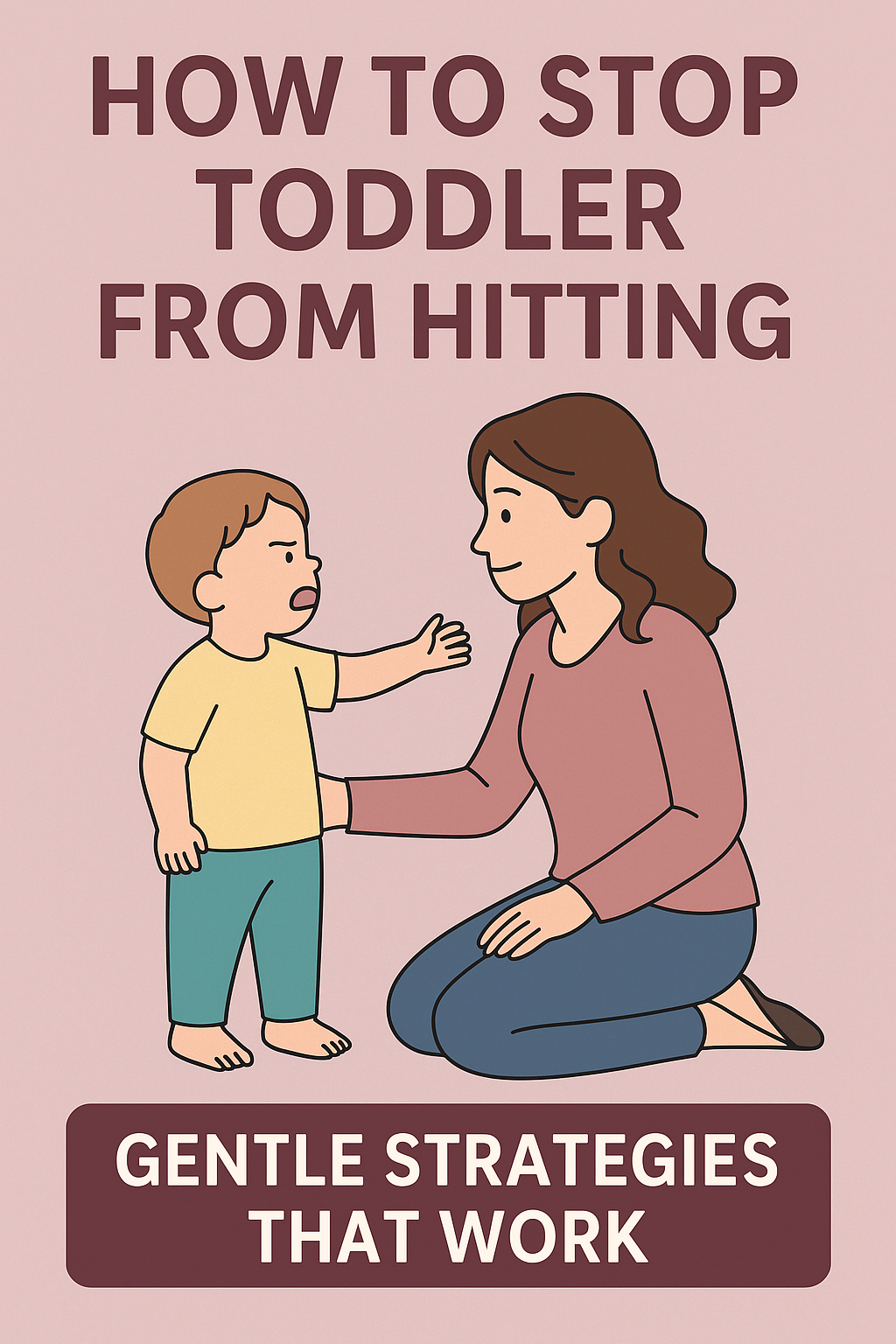How to Stop Toddler From Hitting: Gentle Solutions That Actually Work
Struggling with a toddler who hits when they’re angry, frustrated, or even just overexcited?
You’re not alone — and you’re not a bad parent. Learning how to stop toddler from hitting is a key part of building emotional intelligence, respectful behavior, and long-term self-regulation.
In this guide, you’ll find practical tips, gentle discipline tools, and real-life strategies that work — even when you’re exhausted and nothing else has helped.
Heads up: This post may include affiliate links. As an Amazon Associate, I earn from qualifying purchases—at no extra cost to you. Full privacy policy and disclosure here.

Why Toddlers Hit: Understanding the Behavior
Toddlers hit for a simple reason: they’re still learning how to deal with big emotions. When they feel frustrated, overstimulated, or even excited, they may lash out physically because they don’t yet have the tools to express themselves in words.
Developmentally, this is normal.
Hitting can be:
- A way to communicate frustration
- A response to sensory overload
- A form of play (especially if they’ve seen others do it)
- A reaction to lack of impulse control
👉 According to the American Academy of Pediatrics, aggression in toddlers is common between ages 18 months and 3 years — but that doesn’t mean you should ignore it.
What Not to Do When Your Toddler Hits
Before jumping into discipline strategies, let’s talk about what to avoid.
❌ Don’t hit back. Spanking or hitting a toddler teaches them that physical aggression is a valid response to conflict.
❌ Don’t shame or embarrass. Saying things like “you’re mean” or “you’re bad” can damage a child’s self-concept.
❌ Don’t yell. While understandable in the heat of the moment, yelling often escalates the behavior or models more aggression.
Instead, focus on calm, firm responses that teach rather than punish.

Gentle Strategies to Stop Toddler Hitting
1. Stay Calm and Get Low
Kneel to your toddler’s level and speak in a low, calm voice. This shows you’re in control — and it helps them feel safe.
Example: “I won’t let you hit. That hurts. Let’s take a breath together.”
2. Set a Clear Boundary
Use a calm but firm tone. Keep it short and simple.
Try: “Hitting hurts. I won’t let you hit people.”
3. Offer Alternatives
Model what they can do instead. This teaches replacement behavior.
“You’re mad. You can stomp your feet or squeeze this pillow.”
Hands Are Not for Hitting (affiliate link) is a great book that introduces this concept for toddlers.
4. Name the Emotion
Help your child learn to label their feelings.
“You’re feeling really angry right now because your toy was taken.”
You can support this with emotion flashcards (affiliate link) or a feelings chart on the fridge.
5. Practice “Time-In,” Not “Time-Out”
Instead of isolating them, sit together in a calm space and help them co-regulate.
Create a cozy calm-down corner with a soft weighted plush animal (affiliate link) or sensory toy.

Helpful Tools to Support Emotional Regulation
Here are some tools that can help you teach and reinforce gentle boundaries at home:
- 📚 No-Drama Discipline (affiliate link) — A must-read parenting book that dives into brain development and discipline.
- 🧠 Calm Down Kit (affiliate link) — Includes tools for helping your toddler settle during meltdowns.
- 🎨 Emotion Dolls (affiliate link) — These are great for pretend play and talking through feelings.
- 💻 Positive Parenting Solutions Course — This course changed how I parent. I cannot recommend it enough.

Scripts: What to Say When Your Toddler Hits
Use these real-life examples to respond calmly and consistently:
| Situation | What You Can Say |
|---|---|
| Hitting a sibling | “I won’t let you hit. You may be upset, but hitting hurts. Let’s take a break and breathe.” |
| Hitting during play | “Too rough. Let’s use gentle hands if we want to keep playing.” |
| Hitting YOU | “I know you’re frustrated. I’m here to help. You can tell me what you need with your words.” |
FAQs: Toddlers Who Hit
Why does my toddler keep hitting me?
They’re likely overwhelmed. Toddlers lack impulse control and can’t always verbalize what they feel. Stay calm, set boundaries, and model better behavior.
How do I discipline a toddler for hitting?
Discipline isn’t about punishment. It’s about teaching. Set a clear limit (“No hitting”), acknowledge the feeling, and redirect to a safe behavior.
Is it normal for toddlers to hit when excited?
Yes! Some toddlers hit when they’re overexcited. Teach them to use gentle hands or clap instead.
When should I worry about toddler aggression?
If the hitting is frequent, extreme, or doesn’t improve with consistent boundaries, consider speaking with your pediatrician or a child therapist.
What’s the best parenting course for toddler discipline?
I personally love the Positive Parenting Solutions course — it offers scripts, tools, and a supportive community to help you stay consistent.
Final Thoughts: Parenting a Toddler Who Hits
Learning how to stop toddler from hitting takes time and patience. Your child is still growing and figuring out how to be in this world. With your guidance — and the right tools — they can learn to express themselves in safer, more respectful ways.
Remember:
- Stay calm.
- Set clear boundaries.
- Be consistent.
- Focus on teaching, not punishing.
You’re doing the work of raising a kind, emotionally intelligent child — even when it’s hard. And that’s worth everything.
🎁 Bonus: Free Printable Download!
Want help teaching gentle boundaries? Download your FREE Positive Discipline Cheat Sheet for Toddlers — a printable guide to keep on the fridge for quick reminders when things get tough.
🛍️ Shop Recommended Tools for Gentle Discipline
| Product | Description |
|---|---|
| Hands Are Not for Hitting | Board book that teaches hands are for helping, not hurting |
| Emotion Flashcards | Help toddlers label their feelings visually |
| Weighted Plush Animal | Comfort item for self-soothing |
| Calm Down Kit | Filled with sensory tools for emotional regulation |
| No-Drama Discipline Book | Parenting strategies grounded in brain science |
🌐 Explore More Resources
- CDC Positive Parenting Tips for Toddlers
- Zero to Three on Toddler Aggression
- Positive Parenting Solutions Course
📌 Save this pin for later so you’ll have gentle discipline tools ready the next time your toddler hits.
✔ Discover real-life scripts, calm-down tools, and a free printable to guide you step by step!

